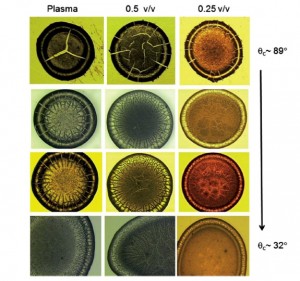When a drop is applied to a surface and dries, a number of factors control the formation of the dried drop. Essentially as the fluid or solvent evaporates, capillary flow transports molecules to the contact line of the drop with the surface and the drop dries as a ring with components coarsely separated, like a coffee ring.
Drop deposition of biofluids is being investigated worldwide as a possible diagnostic tool. However, the parameters that affect the formation of the biofluids coffee ring are not fully understood and this is a barrier that needs to be overcome in order to realise the clinical potential of drop deposited biofluids. Drop deposition is particularly well suited for examining low abundance biofluids such as tears and synovial fluids but is also widely investigated for blood plasma and serum.
A team of US researchers, based at the University of Michigan, have recently published a HOT article characterising biofluids prepared by drop deposition. The researchers studied two model biofluids, blood plasma and synovial fluid, when deposited onto slightly hydrophilic substrates with a contact angle of 50 – 90 degrees. The researchers showed that under most circumstances the model biofluids followed the piling model, as suggested by Deegan et al. and that an increased understanding of the time-dependent rheology and intermolecular forces that occur during evaporation would provide a better approximation. Importantly, from molecular analysis of the drop via Raman spectroscopy, that whilst the morphology of the dried drop changed the chemical composition and molecular structure of the dried proteins within the outer ring were unaffected.
Karen Esmonde-White, one of the authors, comments “The formation of a ring-like structure and compatibility of the drop deposition technique with multiple analytical technologies are well-known features of drop deposition. In this study, we aimed to formalize what is mostly observational data regarding the underlying fluid dynamics of ring formation in drying biofluids. We hope that this work will improve our understanding of the underlying fluid dynamics and their effect on the dried deposit shape and chemical composition. These fundamental studies allow us to define sources of experimental variability in the drop deposition technique and improve its reproducibility. The eventual aim of these studies is clinical translation for examining rheological and chemical changes in synovial fluid associated with joint diseases”.
Karen A. Esmonde-White, Francis W. L. Esmonde-White, Michael D. Morris and Blake J. Roessler
Analyst, 2014,139, 2734-2741
DOI: 10.1039/C3AN02175K











